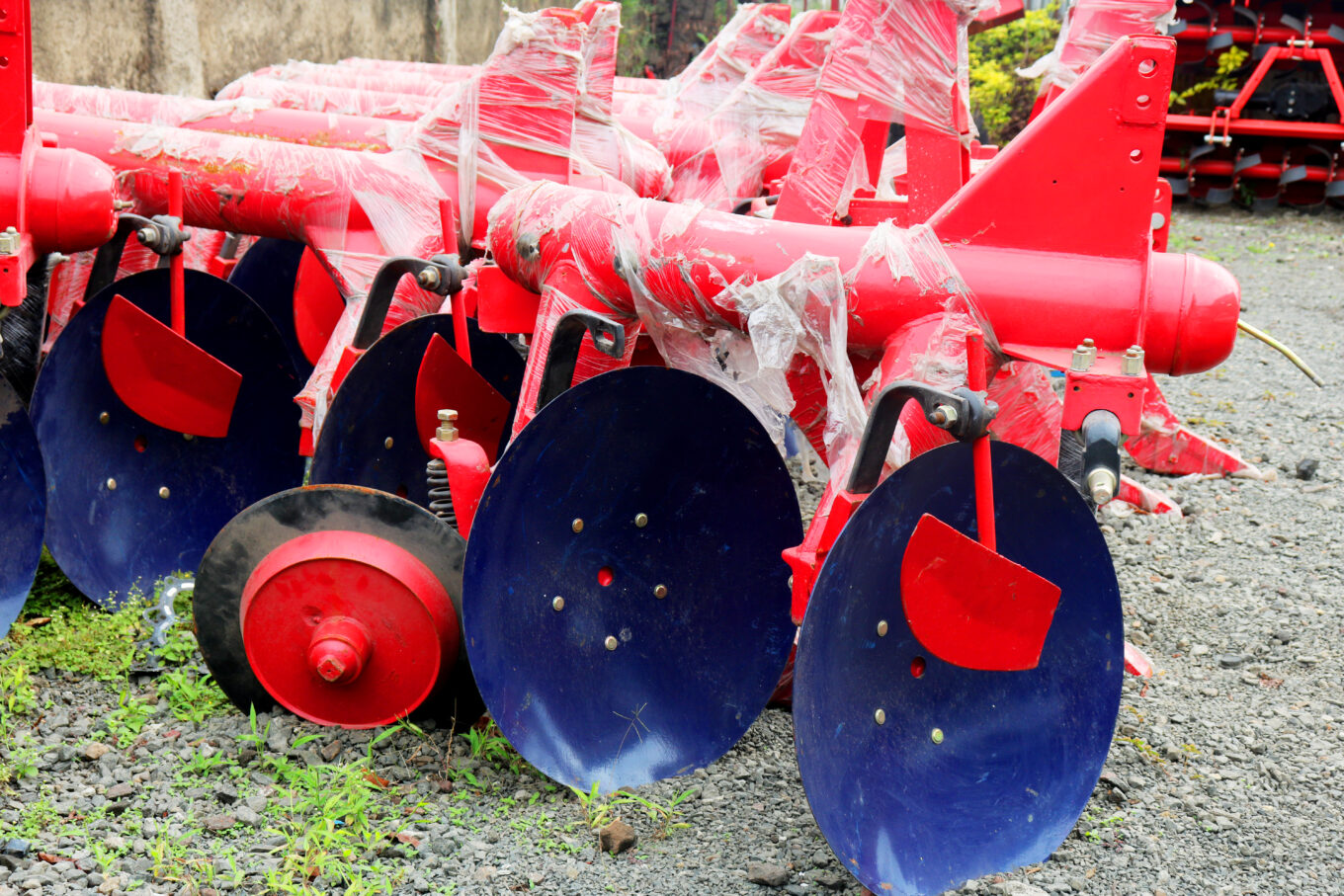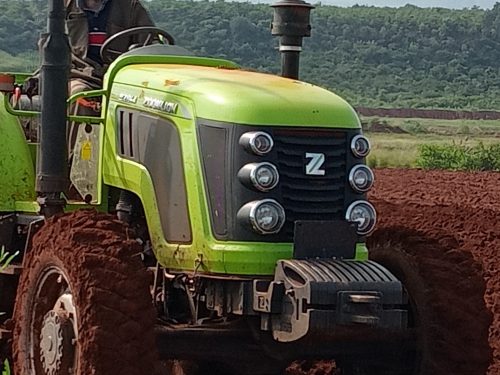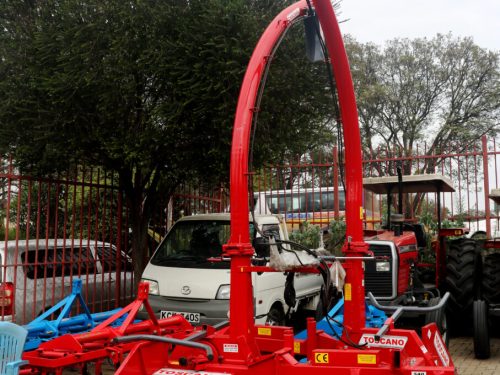Description
Disc plough for sale in Kenya.

Disc plough cuts, turns and in some cases breaks furrow slices by means of separately mounted large steel concave discs. It is designed with a view to reduce friction by making a rolling plough bottom instead of sliding plough bottom. A disc plough works well in the conditions where other types of ploughs like chisel and mouldboard ploughs cannot be incorporated. They are equipped with heavy-duty tubular frame specially designed for deep ploughing and land preparation of rough soil.
Field conditions where Disc plough can be applied.
- It works well in sticky soils in which a mouldboard plough does not scour.
- It can be used safely in rough, stony and stumpy soils without much danger of
Types of Disc Plough:
Disc plows are categorized into three main categories as tractor drawn, bullock drawn and according to mounting of the discs.
- Bullock drawn: This category include sulky type where the plough is attached directly into the two wheels of the plough, and gang type where the disc plough is attached to universal frame which is mounted on two wheels.
- Tractor drawn disc plough: Where the disc plough is directly mounted on the tractor, semi-mounted where the disc plough is partly mounted on a tractor and partly pulled manually, and also trailed where the disc plough and the tractor form one embodiment.
- According to mounting of Discs: Which are standard disc plough and vertical disc ploughs.
-
Standard disc ploughs.

Standard disc plough are sold in three different forms which includes Three bottom mounted type standard disc plough, six bottom trail type standard disc plough, and four bottom mounted type reversible standard disc plough. It has a series of individually mounted inclined disc blades on a frame supported by wheel. They have scrapers that are used for assisting discs in covering trash and prevent soil build up on disc in sticky soil conditions.
The reversible standard disc plough are usually of mounted or semi-mounted type and have an arrangement to reverse the disc angle at each end of field to permit one way plowing. They are used in hard and dry soil. The disc tools are forced into ground by effect of gravity upon its mass rather than suction.
Specifications
- The mounting of the discs is on individual axis.
- The number of discs ranges from 1-6.
- Disc sizes are approximately 60-75cm diameter.
- The concavity of the disc is more than that of vertical disc plough.
- The depth of cut is about 30-40 cm.
- Angle of tilt to the direction of travel is about 42-45 degrees.
- The tilt backward angle of the discs is 15-25 degrees.
- The weight of standard disc plough is about 200-600 kg. The draft requirement is relatively high as compared to the vertical disc type which is low.
-
Vertical disc plough.
Vertical disc ploughs are used in plain areas and where shallow plowing and mixing of stubble with soil is required. It is also called as one-way disc plough. At some point, it is similar to pull type and standard disc plough but discs are uniformly spaced along a common axle or gang bolt and clamped together through spacer spools so the entire gang rotates as a unit .It is generally used in plain areas and where shallow plowing and mixing of stubble with soil is required.
Specifications
- Vertical disc plough discs are mounted onto a common axis.
- The number of discs ranges between 5-24 per mounter.
- The discs sizes are 60-75cm.
- The disc concavity is less than that of the standard disc plough.
- The depth of cut of the disc is about 8-10cm.
- The angle of tilt to the direction of travel is about 42 -45 degrees.
- The tilt backward angle is zero degrees.
- The total weight of the vertical disc plough estimated as 50-100kg.
- The draft requirement is a bit low as compared to that one of the standard type disc plough.

Design components of disc plough.
The common disc ploughs consists of the following parts.
-
Plough Frame
This is where all the system components are attached. It has provision for disc angle adjustment, adding or removing standard and discs.
-
Disc blade
Disc type blades are mounted for cutting of soil. Number of blades and diameter determine plough capacity. Concavity affects disc angle and soil turning. Shallow concavity depends on diameter of discs. Depth of cut depends on diameter of discs width of cut depends on diameter of blade. Width of cut is normally a third times diameter of disc blade.
-
Rear Furrow Wheel
To stabilize the plough and take side thrust, rear furrow wheel is fixed at end
-
Scraper
This is a device used to remove soil that tends to stick to working surface of a disc for great pulverization to furrow slice. It inverts the furrow slice and covers the trash better. They are of three types namely: Disc scraper used in non-scouring soils, board scraper used to turn over soil and trash, and hoe scraper used in sticky soils conditions.
-
The disc
This is a circular, concave revolving steel plate used for cutting and inverting the soil. The angle of operation is called disc angle, which is the angle at which the plane of the cutting edge of the disc is inclined to the direction of travel.
-
Land side
Is the flat plate which bears against and transmits lateral thrust of the plough bottom to the furrow wall. It helps to resist the side pressure exerted by the furrow slice on the moldboards. It also helps in stabilizing the plough while it is in operations.
-
Frog
Frog is that part of the plough bottom to which the other components of the plough bottom are attached. It is an irregular piece of metal. It may be made of cast iron for cast iron ploughs or it may be welded steel for steel ploughs.
-
Tail piece
It is an important extension of moldboard which helps in turning a furrow slice.
-
Disc coulter
A device used to cut the furrow slice vertically from the land ahead of the plough bottom. It cuts the furrow slice from the land and leaves a clear wall. It also cuts trashes which are covered under the soil by the plough. The coulter may be of rolling type disc coulter or sliding type knife coulter.
-
Furrow wheel
It is an auxiliary wheel of an implement to maintain uniform depth of working thus helps to maintain uniformity in respect of depth of ploughing in different soil conditions. It is usually placed in hanging position.
Proper adjustments that should be made on a disc plough.

- Cutting Angle Adjustment: The discs would not cut if they are rolled straight ahead. They must be set at an angle. Provision is made in the plough standard for the adjustment of the horizontal disc angle and vertical tilt angle to obtain optimum disc operation indifferent soil conditions.
- The Width of cut adjustment: Every disc plough has a particular width of cut ranging from 18-25 cm depending on the diameter of the blade. The width of the cut for the front disc can be adjusted with the help of cross shaft, which has an index line which can be lined up with different markings on the cross shaft carrier.
- Leveling the plough: The level of the plough is controlled by the tractor top link. If the rear end of the plough beam is higher than the front end of the beam, top link should be lengthened. If rear end of the plough beam is lower than the front end, then shorten the top link. Lateral leveling is controlled by adjusting the length of the tractor right lower link. These adjustments must be made with the plough before starting the operation.
- Tightening the bearing: The Bearings and the nuts must be kept tight until the disc binds the hub.
- Scrapper adjustments: Scrappers are set low enough to catch and turn the furrow slice before it falls away from the disc. For deeper ploughing, the scrapper has to be set a little higher. For sticky soils, set them closer to the disc.
- Adjustments for deeper ploughing: for obtaining the depth of the plough the of draft and control levers of the tractor is very important . More depth can be obtained by adding extra weight to the plough and reducing the tilt angle.
Advantages
- Disc ploughs works well in sticky soil in which a mouldboard plough cannot perform.
- They are more useful for deep ploughing.
- Disc plough can be used in stony and stumpy soil without much danger of breakage.
- A disc plough works well even after a considerable part of disc is worn off in abrasive soil.
- It can also perform in loose soils without much clogging.
- When scrapers are fitted it also inverts the soil.
- Disc ploughs has more mixing action rather than inversion.
- The maintenance cost is low, as there are no shares to replace or sharpen as compared to mould board plough.
Disadvantages of Disc Plough:
- Disc ploughs cannot be operated at high speed since for cutting action at slow speed is necessary.
- Discs are not suitable for covering surface trash and weeds as effectively as mould board plow.
- It leaves field rough and cloddy.
- It is heavier than mould board plough therefore offers high penetration as this depends on weight rather than suction.
- .




